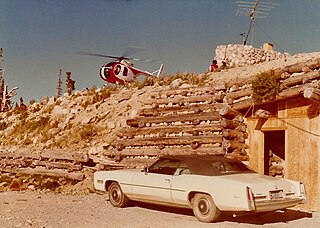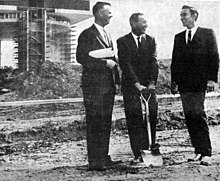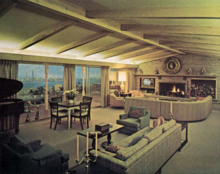
A fallout shelter is an enclosed space specially designated to protect occupants from radioactive debris or fallout resulting from a nuclear explosion. Many such shelters were constructed as civil defense measures during the Cold War.

A world's fair, also known as a universal exhibition or an expo, is a large global exhibition designed to showcase the achievements of nations. These exhibitions vary in character and are held in different parts of the world at a specific site for a period of time, typically between three and six months.

The Century 21 Exposition was a world's fair held April 21, 1962, to October 21, 1962, in Seattle, Washington, United States. Nearly 10 million people attended the fair during its six-month run.

The 1964–1965 New York World's Fair was a world's fair that held over 140 pavilions and 110 restaurants representing 80 nations, 24 U.S. states, and over 45 corporations with the goal and the final result of building exhibits or attractions at Flushing Meadows–Corona Park in Queens, New York City. The immense fair covered 646 acres (2.61 km2) on half the park, with numerous pools or fountains, and an amusement park with rides near the lake. However, the fair did not receive official support or approval from the Bureau of International Expositions (BIE).

The Palace of Fine Arts is a monumental structure located in the Marina District of San Francisco, California, originally built for the 1915 Panama–Pacific International Exposition to exhibit works of art. It was constructed from concrete and steel, and the building was claimed to be fireproof. According to a metal plate at the rotunda, it was rebuilt under B.F. Modglin, local manager of MacDonald & Kahn, between 1964 and 1967. In the years 1973 and 1974, the columniated pylons were added. It is the only structure from the exposition that survives on site.

Yorkdale Shopping Centre, Yorkdale Mall, or simply Yorkdale, is a major retail shopping centre in Toronto, Ontario, Canada. Located at the southwest corner of the interchange between Highway 401 and Allen Road, it opened in 1964 as the largest enclosed shopping mall in the world. Yorkdale is currently the third largest shopping mall in Canada by floor space and has the highest sales per unit area of any mall in Canada, with current merchandise sales levels at roughly CA$1,905 per square foot. At 18 million annual visitors, it is one of the country's busiest malls. Many international retailers have ventured the Canadian market initially at Yorkdale.

The Queens Museum is an art museum and educational center at Flushing Meadows–Corona Park in the borough of Queens in New York City, New York, U.S. Established in 1972, the museum has among its permanent exhibitions the Panorama of the City of New York, a room-sized scale model of the five boroughs originally built for the 1964 New York World's Fair. It also has a large archive of artifacts from both the 1939 and 1964 World's Fairs, a selection of which is on display. As of 2018, Queens Museum's director is Sally Tallant.

The Las Vegas Convention Center is a convention center in Winchester, Nevada. It is owned and operated by the Las Vegas Convention and Visitors Authority.

Santa Monica Civic Auditorium is a multi-purpose convention center at 1855 Main Street in Santa Monica, California, owned by the City of Santa Monica. It was built in 1958 and designed by Welton Becket and as a concert venue, it has a seating capacity of 3,000.

Mandalay Bay Convention Center is attached to the Mandalay Bay resort, located on the Las Vegas Strip in Paradise, Nevada. The 2,100,000 sq ft (200,000 m2) facility is owned and operated by MGM Resorts International. It is among the largest convention centers in the U.S.

The Kay Bailey Hutchison Convention Center is a convention center in the Convention Center District of downtown Dallas, Texas.

On December 27, 1832, two years after the organization of the Church of Christ, the movement's founder, Joseph Smith, stated he received a revelation that called upon church members to restore the practice of temple worship. The Latter Day Saints in Kirtland, Ohio were commanded to:
"Establish a house, even a house of prayer, a house of fasting, a house of faith, a house of learning, a house of glory, a house of order, a house of God."

Girard B. Henderson was an American business man and philanthropist. He was a director of Avon Products and the founder of the Alexander Dawson Schools. The author Donald Porter described him as a "short, tough-talking millionaire".

Dizengoff Center is a shopping mall at the intersection of Dizengoff Street and King George Street in Tel Aviv, Israel. The mall is named for Meir Dizengoff, the first mayor of Tel Aviv.
Escondido Village at Valley and Ash in Escondido, California, now a suburb of San Diego, was the first enclosed, and first fully air-conditioned shopping mall in California, opening on March 9, 1964, costing $10 million to build. It was advertised as a shopping center with an "enclosed sidewalk" or "an air-conditioned sidewalk and mall", as the term "mall" was not yet synonymous with an enclosed shopping center, but rather its original meaning of a long, planted or green space. Walker Scott, the San Diego-based department store chain was an anchor, as was Mayfair Markets, TG&Y discount stores joining later. At launch, the center was 1,200-foot (370 m) long on a single-axis mall, had 200,000 square feet (19,000 m2) of gross leasable area, 40 stores, and 30 acres (120,000 m2) of parking for 1,250 cars. Sears joined later as the second department store anchor with 120,000 sq ft (11,000 m2)

75 Wall Street is a 43-story mixed-use building in the Financial District of Lower Manhattan in New York City. It contains Hyatt Centric Wall Street New York, a hotel with 253 rooms managed by Blue Sky Hospitality.

Julian Harvey "Jay" Swayze was an architect from Plainview, Texas best known for his creation of Underground World Home at the 1964 New York World's Fair, which proved to be not popular at the fair. During his career he was a promoter of underground living and he wrote a book called: Underground gardens & homes: The best of two worlds, above and below.
Atomitat (1962) was an underground bunker-home in Plainview, Texas, designed by architect Jay Swayze. The name of the home came from the combination of the words "atomic" and "habitat". It was the first home in the U.S. to meet civil defense specifications for a nuclear shelter.

The Underground House in Las Vegas, Nevada, is a Cold War-era subterranean dwelling. This structure was built in the wake of the Cuban Missile Crisis.The house was completed in the 1978.

The Underground House in Ward, Colorado, was a subterranean dwelling known for its architectural design, which embraced the concept of underground living. The house was designed by architect Julian "Jay" Swayze (1923–1981) in the 1960s. The dwelling is an example of an unconventional approach to residential construction and integration with the natural environment. It was included in the Underground World Home exhibit at the 1964 New York World's Fair.





















